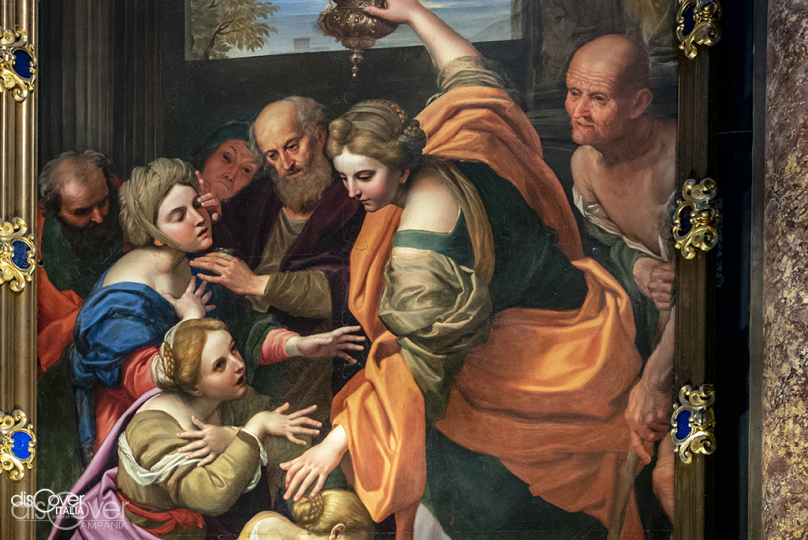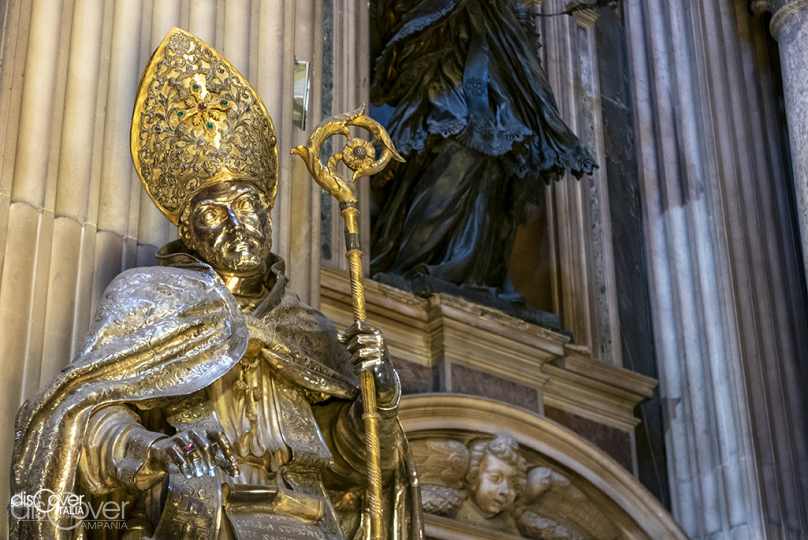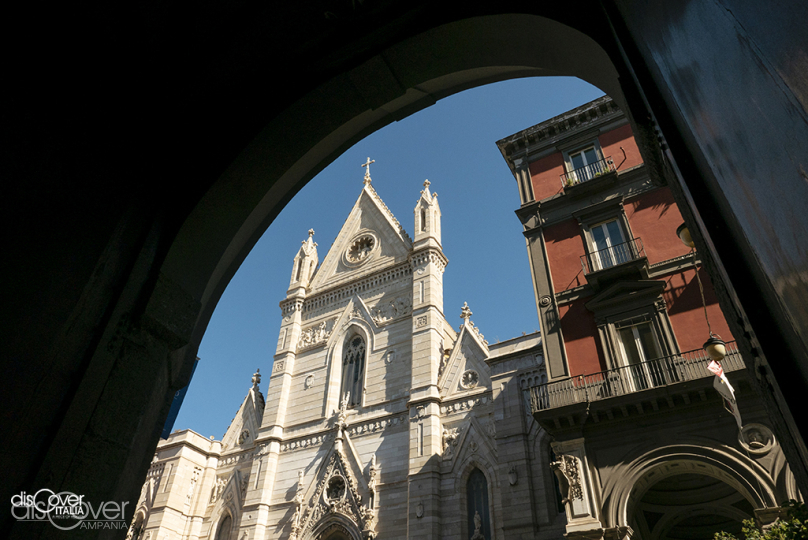The new Gothic cathedral entirely incorporated the pre-existing basilica of Santa Restituta. Struck by the earthquakes of 1349 and 1456, subsequent reconstructions enriched the mother church with the Succorpo Chapel and the Royal Chapel of the Treasure of San Gennaro. Other damage came with the bombs of the Second World War, which was followed by other restoration interventions.
The Dome
The current fifty meter high façade, in neo-Gothic style, was rebuilt to a design by the architect Enrico Alvino between 1877 and the early 1900s. It has three portals surmounted by elements of the original Angevin façade. The central portal is supported by two lions by Tino di Camaino, like the Madonna and Child above.
The interior has a Latin cross layout, with three naves separated on each side by eight African granite pillars, which support the Gothic pointed arches, which in turn support the trusses of the older ceiling, transformed in 1621 into a coffered ceiling. On each side of the church there are five side chapels with valuable altars and funerary monuments. On the counter-façade are the tombs of Charles I of Anjou, Charles Martel of Anjou, and his wife Clemenza of Habsburg.
Celebrations linked to the miracle of the blood of San Gennaro take place in the Cathedral. It takes place three times a year: the first Saturday in May, 19 September and 16 December.

The Succorpo Chapel
From the transept you enter the Succorpo Chapel, the crypt of the Cathedral, also known as the Chapel of San Gennaro or the Carafa Chapel, because it was Cardinal Oliviero Carafa who commissioned it in 1497, when the relics of San Gennaro returned to the city from the sanctuary of Montevergine. Then they were placed under the bronze altar. The crypt is divided into three naves by ten ancient columns with Ionic capitals. It is covered in precious marble, with side niches and a fine coffered ceiling.
The Basilica of Santa Restituta
The entrance to the early Christian basilica dedicated to the holy martyr Restituta is from the left nave of the cathedral. It was Constantine I who ordered its construction. The chapel is divided into three naves by Corinthian columns. The Baptistery of San Giovanni in Fonte, the oldest in the West, is made up of a rectangular portico and the baptismal hall with part of the original mosaics depicting scenes from the Bible. Below the basilica is the Greco-Roman and early Christian archaeological area.
USEFUL INFORMATION
Entrance to the Cathedral of Naples is free and can take place at the following times: From Monday to Saturday 8.30am – 1.30pm / 2.30pm – 7.30pm Sunday 8.00am – 1.00pm / 4.30pm – 7.30pm
Royal Chapel of the Treasure of San Gennaro
Construction began on 8 June 1608, designed by the architect Francesco Grimaldi. The space was created by demolishing the church of Sant'Andrea, three chapels of the Duomo and even some surrounding houses.
With a Greek cross plan, it is in Neapolitan Baroque style. The main altar stands out in the center of the presbytery, which also houses two side altars and two others at the bases of the pillars that support the dome. All around the nineteen bronze sculptures of the city's co-patrons are exhibited. The sculpture of San Gennaro is from 1645, located near the main altar, where the miracle vials with blood are kept and, above the altar, the bust of the Saint with the skull bones. The chapel is connected to the Treasure of San Gennaro Museum with works of art, jewels, statues, busts and fine fabrics, gifts from kings and queens to the Saint.

USEFUL INFORMATION
Entrance to the Treasure of San Gennaro museum takes place every day at the following times: From Monday to Saturday: 9.30am-5.30pm last entry at 5pm Sunday: 9.30am-1.30pm last entry at 1pm :00
Price 5 euros reduced 4; for children up to 6 years and disabled people free.
Ramps for disabled people.
Free QR code at the ticket office with multimedia visit





